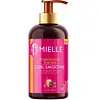What's inside
What's inside
 Key Ingredients
Key Ingredients

No key ingredients
 Benefits
Benefits

 Concerns
Concerns

 Ingredients Side-by-side
Ingredients Side-by-side

Water
Skin ConditioningCocos Nucifera Oil
MaskingGlycerin
HumectantIsopropyl Myristate
EmollientCaprylic/Capric Triglyceride
MaskingStearyl Alcohol
EmollientPolyquaternium-11
Parfum
MaskingCeteareth-20
CleansingDimethicone
EmollientGlycine Soja Oil
EmollientOrbignya Oleifera Seed Oil
EmollientMauritia Flexuosa Fruit Oil
Skin ConditioningCopaifera Officinalis Resin
MaskingAstrocaryum Murumuru Seed Butter
EmollientPanthenol
Skin ConditioningPunica Granatum Extract
AstringentHydrolyzed Soy Protein
HumectantHoney
HumectantPropanediol
SolventC13-14 Isoparaffin
EmollientCarbon
Phenoxyethanol
PreservativePolyacrylamide
Steareth-2
EmulsifyingOleth-10
EmulsifyingAminomethyl Propanol
BufferingBenzoic Acid
MaskingDehydroacetic Acid
PreservativeLaureth-7
EmulsifyingDisodium EDTA
Limonene
PerfumingLinalool
PerfumingBenzyl Alcohol
PerfumingWater, Cocos Nucifera Oil, Glycerin, Isopropyl Myristate, Caprylic/Capric Triglyceride, Stearyl Alcohol, Polyquaternium-11, Parfum, Ceteareth-20, Dimethicone, Glycine Soja Oil, Orbignya Oleifera Seed Oil, Mauritia Flexuosa Fruit Oil, Copaifera Officinalis Resin, Astrocaryum Murumuru Seed Butter, Panthenol, Punica Granatum Extract, Hydrolyzed Soy Protein, Honey, Propanediol, C13-14 Isoparaffin, Carbon, Phenoxyethanol, Polyacrylamide, Steareth-2, Oleth-10, Aminomethyl Propanol, Benzoic Acid, Dehydroacetic Acid, Laureth-7, Disodium EDTA, Limonene, Linalool, Benzyl Alcohol
Water
Skin ConditioningAloe Barbadensis Leaf
MaskingCetearyl Alcohol
EmollientGlycerin
HumectantDistearoylethyl Dimonium Chloride
Caprylic/Capric Triglyceride
MaskingHydrolyzed Quinoa
Skin ConditioningGluconolactone
Skin ConditioningSodium Benzoate
MaskingCalcium Gluconate
HumectantPotassium Sorbate
PreservativeBenzyl Acetate
MaskingLinalyl Acetate
MaskingCitronellol
PerfumingAbies Balsamea Needle Oil
MaskingJuniperus Virginiana Oil
MaskingAlpha-Terpinene
PerfumingAmyl Cinnamal
PerfumingLinalool
PerfumingPogostemon Cablin Leaf Oil
MaskingSalvia Sclarea Oil
MaskingCitrus Reticulata Peel Oil
MaskingMentha Citrata Herb Oil
PerfumingEugenia Caryophyllus Oil
Michelia Alba Leaf Oil
MaskingLavandula Angustifolia Oil
MaskingCitrus Limon Peel Oil
MaskingCitrus Aurantifolia Oil
CleansingLavandula Hybrida Oil
EmollientCinnamomum Camphora Bark Oil
MaskingAlpha-Ionone
PerfumingEvernia Prunastri Extract
PerfumingAnisaldehyde
MaskingCistus Ladaniferus Resin
MaskingMenthol
MaskingMyristica Fragrans Kernel Oil
MaskingJasminum Grandiflorum Flower Extract
MaskingNerol
PerfumingBenzaldehyde
MaskingChamomilla Recutita Flower Extract
MaskingEucalyptus Globulus Leaf Extract
PerfumingGinkgo Biloba Leaf Extract
Skin ConditioningAspalathus Linearis Leaf Extract
Skin ConditioningHoney Extract
HumectantCalophyllum Inophyllum Seed Oil
AntimicrobialRosmarinus Officinalis Leaf Oil
MaskingCitric Acid
BufferingEugenol
PerfumingLimonene
PerfumingWater, Aloe Barbadensis Leaf, Cetearyl Alcohol, Glycerin, Distearoylethyl Dimonium Chloride, Caprylic/Capric Triglyceride, Hydrolyzed Quinoa, Gluconolactone, Sodium Benzoate, Calcium Gluconate, Potassium Sorbate, Benzyl Acetate, Linalyl Acetate, Citronellol, Abies Balsamea Needle Oil, Juniperus Virginiana Oil, Alpha-Terpinene, Amyl Cinnamal, Linalool, Pogostemon Cablin Leaf Oil, Salvia Sclarea Oil, Citrus Reticulata Peel Oil, Mentha Citrata Herb Oil, Eugenia Caryophyllus Oil, Michelia Alba Leaf Oil, Lavandula Angustifolia Oil, Citrus Limon Peel Oil, Citrus Aurantifolia Oil, Lavandula Hybrida Oil, Cinnamomum Camphora Bark Oil, Alpha-Ionone, Evernia Prunastri Extract, Anisaldehyde, Cistus Ladaniferus Resin, Menthol, Myristica Fragrans Kernel Oil, Jasminum Grandiflorum Flower Extract, Nerol, Benzaldehyde, Chamomilla Recutita Flower Extract, Eucalyptus Globulus Leaf Extract, Ginkgo Biloba Leaf Extract, Aspalathus Linearis Leaf Extract, Honey Extract, Calophyllum Inophyllum Seed Oil, Rosmarinus Officinalis Leaf Oil, Citric Acid, Eugenol, Limonene
 Reviews
Reviews

Alternatives
Ingredients Explained
These ingredients are found in both products.
Ingredients higher up in an ingredient list are typically present in a larger amount.
This ingredient is an emollient, solvent, and texture enhancer. It is considered a skin-softener by helping the skin prevent moisture loss.
It helps thicken a product's formula and makes it easier to spread by dissolving clumping compounds.
Caprylic Triglyceride is made by combining glycerin with coconut oil, forming a clear liquid.
While there is an assumption Caprylic Triglyceride can clog pores due to it being derived from coconut oil, there is no research supporting this.
Learn more about Caprylic/Capric TriglycerideGlycerin is already naturally found in your skin. It helps moisturize and protect your skin.
A study from 2016 found glycerin to be more effective as a humectant than AHAs and hyaluronic acid.
As a humectant, it helps the skin stay hydrated by pulling moisture to your skin. The low molecular weight of glycerin allows it to pull moisture into the deeper layers of your skin.
Hydrated skin improves your skin barrier; Your skin barrier helps protect against irritants and bacteria.
Glycerin has also been found to have antimicrobial and antiviral properties. Due to these properties, glycerin is often used in wound and burn treatments.
In cosmetics, glycerin is usually derived from plants such as soybean or palm. However, it can also be sourced from animals, such as tallow or animal fat.
This ingredient is organic, colorless, odorless, and non-toxic.
Glycerin is the name for this ingredient in American English. British English uses Glycerol/Glycerine.
Learn more about GlycerinLimonene is a fragrance that adds scent and taste to a formulation.
It's found in the peel oil of citrus fruits and other plants such as lavender and eucalyptus. The scent of limonene is generally described as "sweet citrus".
Limonene acts as an antioxidant, meaning it helps neutralize free radicals.
When exposed to air, oxidized limonene may sensitize the skin. Because of this, limonene is often avoided by people with sensitive skin.
The term 'fragrance' is not regulated in many countries. In many cases, it is up to the brand to define this term. For instance, many brands choose to label themselves as "fragrance-free" because they are not using synthetic fragrances. However, their products may still contain ingredients such as essential oils that are considered a fragrance.
Learn more about LimoneneLinalool is a fragrance and helps add scent to products. It's derived from common plants such as cinnamon, mint, citrus, and lavender.
Like Limonene, this ingredient oxidizes when exposed to air. Oxidized linalool can cause allergies and skin sensitivity.
This ingredient has a scent that is floral, spicy tropical, and citrus-like.
Learn more about LinaloolWater. It's the most common cosmetic ingredient of all. You'll usually see it at the top of ingredient lists, meaning that it makes up the largest part of the product.
So why is it so popular? Water most often acts as a solvent - this means that it helps dissolve other ingredients into the formulation.
You'll also recognize water as that liquid we all need to stay alive. If you see this, drink a glass of water. Stay hydrated!
Learn more about Water